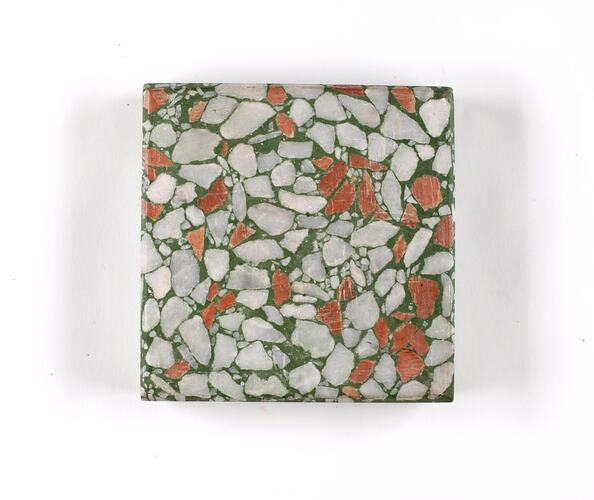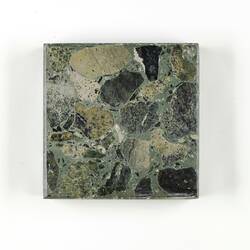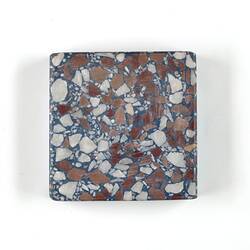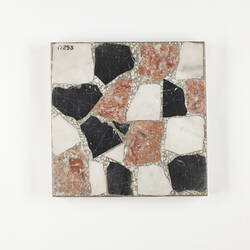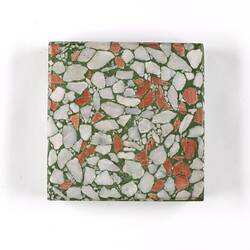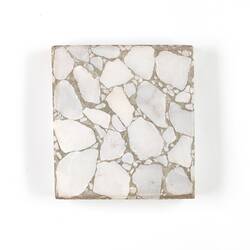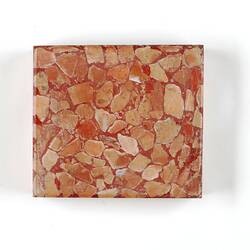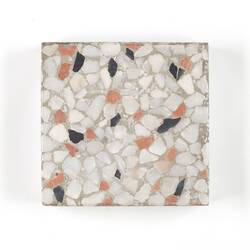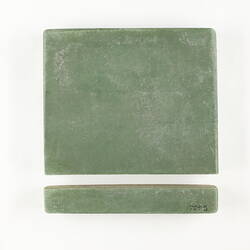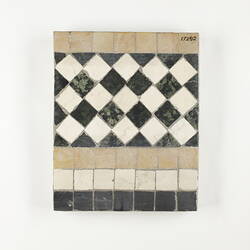Summary
The De Marco Brothers Terrazzo Granolithic and Concrete Placing was established in Melbourne circa 1914 by Italian brothers Annibale and Severino De Marco. Employing predominantly Italian migrants they worked on a variety of project types and scales. Their most successful years were from 1936-1939 when they worked on many prominent Melbourne buildings. Their most notable projects were completed interstate, including mosaic work for Winthrop Hall, UWA and the Hall of Memory at the Australian War Memorial.
The Early Years
The De Marco Brothers Terrazzo Granolithic and Concrete was established in Melbourne, Victoria circa 1914 by Italian brothers Annibale (aka Ernesto) and Severino De Marco. It followed on from an earlier business 'Art Pavement' established by Annibale in 1912. Advertising as specialists in mosaic, terrazzo, Ironite, Florite, granolithic and concrete flooring, they maintained business through two world wars and the Great Depression - their wide range of services providing them with scope to work on large scale projects when times were good and smaller jobs when the going was tough.
Initially based at a factory at 69 La Trobe Street, Melbourne, business started slowly for the De Marco Brothers. In fact, in their first decade of operation, there is only one project on record - the Union Bank of Australia (circa 1914). No doubt, the start of World War I in August of 1914 hampered the growth of business, as it did for many; however the brothers persevered, relying on smaller domestic projects for income during the war years. It was their work during this time that introduced terrazzo to Australia and popularised its use as a bathroom finish through their use of it in eastern suburbs homes.
Business Builds
By 1924, the company had managed to generate enough money to purchase a modest property at the corner of Douglas and Meaden Streets, South Melbourne, which they leased to another manufacturing business. From the mid 1920s business improved. The company was contracted for a variety of construction projects in Melbourne's CBD which included the 'terraza' paving of Queen's Walk (circa 1925); Batman Memorial Slab (circa 1925) which commemorated the landing site of John Batman in Melbourne; the Allied Societies' Trust's Building (circa 1927), home to the Royal Victorian Institute of Architects at 53 Collins Place, and refurbishments to The State Theatre, now known as The Forum Theatre at the corner of Flinders and Russell Streets (circa 1929).
The Great Depression
But just as work began to pick up, the Great Depression of the 1930s looked to deliver more business setbacks for the De Marco Brothers. Unemployment rates were high and many city building projects around Australia were abandoned due to lack of money. Dominic, Annibale's son recalls men standing in line outside the De Marco Brother's factory during the Great Depression hoping for work. He remembers that Annibale would give different men work each day so each man had some money to take home to their family.
Remarkably, at this time Severino De Marco received a major commission for works to Winthrop Hall at the University of Western Australia. The job came courtesy of well-known Melbourne architect, Rodney Alsop (1881-1932). In 1927 Alsop and Conrad Sayce won the world-wide architectural competition for the Hackett Memorial Buildings at the university where Winthrop Hall was to be the centre-piece.
The De Marco Brothers were commissioned by Alsop to lay the mosaic floor to the inside entrance of the hall. Other mosaic work featured in the building included The Five Lamps of Learning which is located above the Great Gateway on the outside of the building. This work was by famed artist Napier Waller, and was his first major commission in Australia after studying mosaic overseas. It is probable that the fixing of The Five Lamps of Learning mosaic was done by De Marco, as Waller had only one arm due to injuries sustained during war service. De Marco would work with Waller again in the mid 1950's on what would be Severino's last major project before his death.
Winthrop Hall's high profile resulted in much media coverage during construction, but while there was much praise for the project, there was also opposition. De Marco's appointment caused quite a stir with local tradesmen, who, in the midst of the Depression and with employment scarce were upset that labour - particularly Italian migrant labour - had been imported from interstate and not sourced locally. A letter from the Operative Stonemasons' Union of Workers, Western Australia exclaims:
'The monies for this Building is local money, why not local men, they understand the trade whereas the Italians have got of [sic] the Boat and gone there, knowing nothing what of it, and British men put off.'
Letter from the Secretary, Operative Stonemasons' Union of Workers Western Australia to the Chairman of the Senate of the University, 10 August 1931
Alsop appointed De Marco for his expertise in mosaic work; De Marco had trained at a premier mosaic school in London and had worked on a number of high profile projects such as South Kensington Museum and St Paul's Cathedral, London. He was highly regarded for his skill and artisanship in mosaic and possessed expertise that the local tradesmen simply did not have.
Business Booms
The effects of the media exposure from Winthrop Hall did not seem to have much impact on The De Marco Brothers company - at least not until the mid 1930s when the bite of the Great Depression eased. From 1935 the company experienced a business boom and between 1935 and 1939 made contributions to a variety of prominent Melbourne building projects. These included retail stores such as Foy & Gibson's department store (circa 1936), Mutual Store Ltd (circa 1936) the Myer Emporium (circa 1938) and Mantons as well as other public buildings such as the Provident Life Assurance Building (circa 1937), T & G Building (circa 1938) and the famous Hotel Australia (circa 1939). It was during this time that they sponsored a number of relatives to come from Italy to work for them including their nephew Gilberto (Gilbert) Girolami and their nephew in law Francesco (Frank) Zannetti, who arrived in 1937 and 1938 respectively.
The De Marco Brothers employed mostly Italian workers - both family relatives and other Italian migrants. Due to strict immigration laws enforced by the 1925 Immigration Act, the number of Italian immigrants allowed entry to Australia was limited and many restrictions were imposed on migrant employment opportunities. This, combined with racial tension between the Italian community and other Australians at the time, goes some way to explaining the dominance of Italian employees at the De Marco Brothers. The brothers' provided their workers with training and experience in a trade that many Italians took naturally to, some of whom eventually left the De Marco Brothers to form their own companies.
With steady company growth and more financial stability, the De Marco Brothers opened a showroom in 1939, just prior to the start of World War II. They were boasting employment of over seventy men and had expanded the company through the purchase of additional property, advertising their new address as the corner of Ferrars and Buckhurst Streets, South Melbourne.
End of a Partnership
From such seeming success in the mid to late 1930s, the impact of World War II must have been felt hard by the business, with virtually no projects documented between the end of 1939 and 1955. During this time, the company experienced many significant changes including the dissolution of Annibale and Severino De Marco's business partnership, which ended in March of 1941, followed just two years later by Annibale's death in 1943. Severino De Marco continued to run the business independently under the De Marco Brothers name for at least another decade, but by the late 1950s the company was bought out by larger Sydney based terrazzo company Melocco Brothers, who absorbed several other small companies in both Sydney and Melbourne around this time.
Final Projects
Severino De Marco's last and possibly most significant work was his involvement in the Australian War Memorial's Hall of Memory, completed in 1955. For this project he teamed again with Napier Waller who was commissioned to design the mosaic work and De Marco was charged with overseeing the fixing of the mosaic sections to the architectural structure. The project was complex with the vast height and domed nature of the ceiling posing many technical challenges. De Marco arranged for Aldo Rossi, a fellow mosaic specialist with whom he had trained in London, to be brought out from Italy especially to work on the project. De Marco and Rossi's success with the Hall of Memory was in their ability to meet the complex technical requirements of the job while maintaining the artistic integrity of Waller's work.
Aside from the work on the Hall of Memory, no further record of the De Marco business exists after their takeover by the Melocco Brothers, the company disappearing after Severino's death circa 1961.
References
Information provided by Dominic de Marco, 2012
Co.As.It. - Italian Historical Society Photographic Collection, record number P-07122, n.d. Giuditta Girolami [nee De Marco] with children Angela Zanetti [Angelina], Gilberto [Gilbert] and Giovanin
Co.As.It. - Italian Historical Society Photographic Collection, record number P-07105, n.d. Studio portrait of Pietro Zanetti and Elisabetta [nee Despirt], with son Francesco [Frank]
Lewis, Miles, n.d. 'Section 7.09' Australian Building: A Cultural Investigation, retrieved 23 April, 2012, http://www.mileslewis.net/australian-building/
Melocco, David 1987, 'The Melocco Brothers', retrieved 26 June, 2012, http://www.virtualtour.com.au/melocco/david's%20dissertation.htm
Melocco Stone, 'History', retrieved 26 June, 2012, http://www.melocco.com.au/html/history.html
National Archives of Australia, Australian War Memorial registry files, series 315, control symbol 234 - multiple records.
National Library of Australia 1941, 'Advertising.', The Argus (Melbourne, Vic. : 1848 - 1956), 3 March, p. 7, retrieved 26 June, 2012, http://nla.gov.au/nla.news-article8161549
National Library of Australia 1939, 'Advertising.', The Argus (Melbourne, Vic. : 1848 - 1956), 21 September, p. 13 Supplement: The Argus building Supplement, retrieved 26 June, 2012, http://nla.gov.au/nla.news-article11247507
Port Phillip Library Service
Public Records Office of Victoria
Sagazio, Celestina 1990 'Terrazzo Contractors', Italian Craftsmanship and Building in Victoria, National Trust of Australia (Victoria), p. 41
State Library of Victoria, Sands & McDougall's directory of Victoria, series 1912-1939, Sands & McDougall, Melbourne
The University of Western Australia Archives Agency 125, series 588 Central Administration Correspondence, consignment 970, file 3431 part 4, Letter from the Secretary, Operative Stonemasons' Union of Workers Western Australia to the Chairman of the Senate of the University, dated 10 August 1931
Tibbits, George, 'Alsop, Rodney Howard (1881-1932)', Australian Dictionary of Biography, National Centre of Biography, Australian National University, retrieved 26 June 2012, http://adb.anu.edu.au/biography/alsop-rodney-howard-5007/text8325
War Memorial 1955, 35mm film, BBC Television, Canberra, Australian Capital Territory
More Information
-
Keywords
Building & Construction, Terrazzo Work, Terrazzo, Italian Immigration, Italian Communities, Working Life
-
Authors
-
Article types
